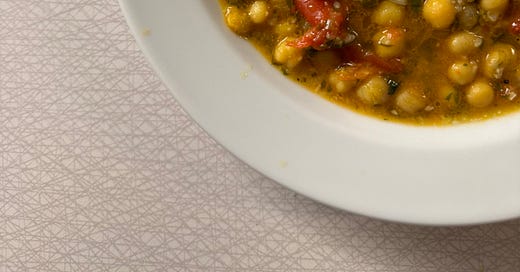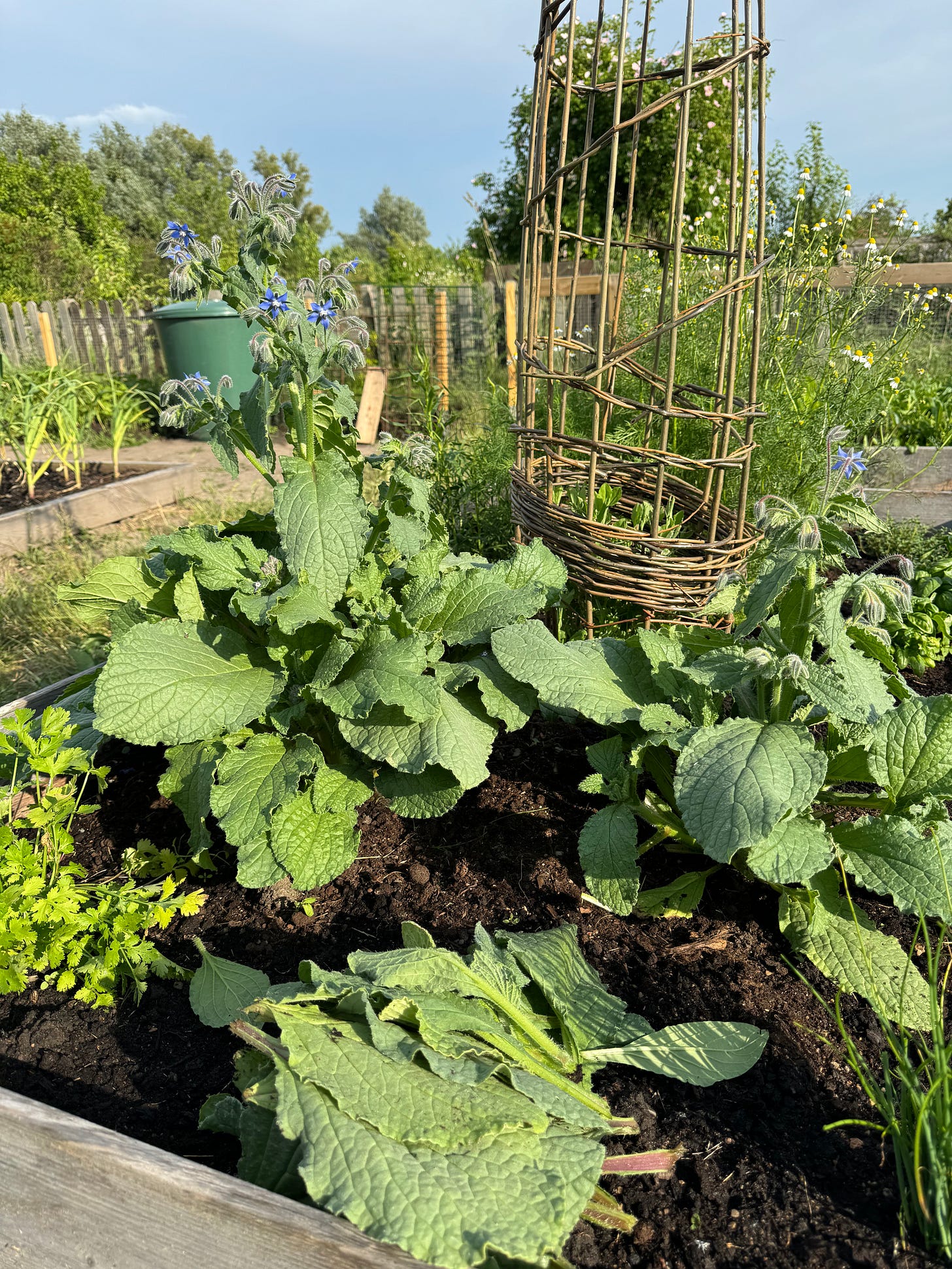The sun has crept into the apartment and it’s only 09.30. I feel lighter.
I see many talking about the hungry gap this week, the month or so where there is little to none fresh produce from the vegetable patch to cook with. Paradoxically, it symbolises a period of culinary delight for me.
One of the first crops from the allotment last year, massively underrated leaves of borage - full of nutrients and a delicious addition to soups and stews.
Don’t get me wrong, nothing is better than that first radish from the allotment. A sigh of relief. But there is something satisfying about constraints and assembling from that. This is a great time to put the remains of last year’s dried legumes to work, adorning them with other pantry staples.
Stewed chickpeas, a force of life.
Home alone for the weekend and in need of a proper meal, I soaked a few chickpeas before going to see The Brutalist. A cinematic epic later, I threw them into our Crockpot (pressure cooker), set the timer to 20 minutes and prepped the rest of the ingredients for cigrons guisats, a Catalan dish of stewed chickpeas.
It relies on picada, a regionally varying blend of chopped ingredients, in this case almonds, garlic, parsley, pine nuts and salt to heighten the flavour in the last act of cooking. Pine nuts can be a revelation yet I rarely find good ones, nor can I truly afford those. I often lean on good almonds, blanched and light roasted, to replace them.
The original recipe called for flour to slightly thicken the stew—we were fresh out of it, so I threw in a tablespoon of almond flour, to great effect.
This is the kind of dish that makes a cool day warmer, a perfect lunch to have on your own or with friends, perhaps with a piece of torn bread and a glass of wine you like.
Cigrons guisats (stewed chickpeas)
For approximately 4 people
200 g chickpeas, soaked with a teaspoon of bicarbonate of soda, rinsed and cooked in plenty of water, salt, a bit of vinegar and a generous glug of olive oil until soft but whole (keep the cooking liquid)
1 onion, thinly sliced
A modest handful of parsley, chopped
Half a tin of tomatoes (around 200 g)
1 tbsp almond flour or 1 teaspoon of flour
Olive oil, salt and pepper
For the picada
10 blanched almonds
A handful of parsley
2 cloves of garlic
Flaky salt / sea salt
Finely chop the ingredients for the picada together and set aside.
Heat 2 tbsp or more of olive oil in a thick-bottomed, wide-ish pan to medium heat. Add the onion and parsley along with a pinch of salt. Sauté until the onions are soft, only slightly starting to take colour.
Add the tomatoes and crush them with a wooden spoon. Stir and cook for 5 minutes so it forms a sauce. Sprinkle in the almond flour, stir and cook for a minute, allowing it to thicken the sauce slightly. Add a cup of the chickpea cooking liquid. Stir.
Add the chickpeas, the picada and a large pinch of (roughly) ground black pepper. Cook for about 10 minutes, pour in a ladle or two of cooking liquid if needed to moisten the stew (there should be plenty of liquor to dip the bread in). Season to taste. Chickpeas should be very tender but whole at the end of it.
Serve with plenty of good olive oil and a squeeze of fresh lemon.
—
A scene from The Brutalist filmed in Carrara. Coincidentally, I’ve been reading a lot about its history and cuisine the past few weeks. It felt strangely transporting.
After seeing The Brutalist, I’ve mostly listened back to its beautiful score by Daniel Blumberg, made alongside an extraordinary group of experimental musicians I love. I can’t get the promise and grandeur of the overture out of my head.
Another evocative soundtrack along those lines is that of Jackie (Pablo Larraín’s fictional portrait of Jackie Kennery), a decent film with an incredible score composed by Mica Levi. Vanity is my favourite track.
—
My friend Agnes got me hooked on the classic Roman (Empire!) beverage of posca, water and good wine vinegar, often enjoyed by troops and peasants in absence of wine (reserved for the higher ups). I’ve elevated it to a tablespoon of Banyuls red wine vinegar and 200 ml sparkling water on ice, drunk as a refreshing alternative to alcohol or simply to quench the thirst after a day of digging in the garden.
—
Following a trip to Japan in January, I get around 10 requests about traveling advice a day on Instagram. To make it easier for you and me both, I’ve decided to publish a newsletter guide with Tokyo bars, restaurants, shops and more, out next week—available to paid subscribers only.
—
Wishing you a great weekend ahead—I hope you eat well!
x Alisa







Never experienced any problems with that myself, and it makes for a nicer flavored legume/cooking liquid.
This looks amazing. I put in ceci seeds just last week.